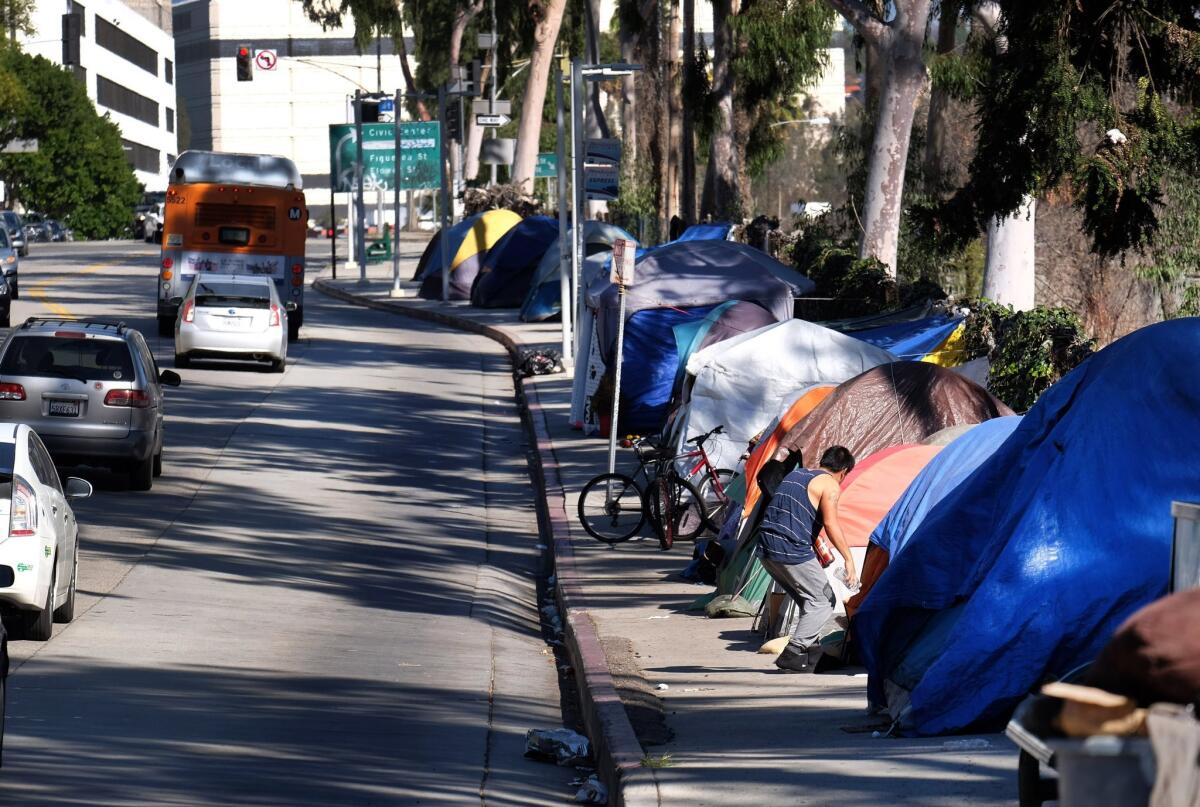How do we keep coronavirus from ravaging L.A.’s homeless encampments?

- Share via
Nothing would exacerbate the public health crisis of homelessness like adding the public health crisis of the coronavirus. Homeless people in Los Angeles County, who already are beset by health problems both chronic and acute, have lifespans two to three decades shorter than people who are housed; last year, more than 1,000 homeless people died on the streets. A substantial portion of the homeless population is 55 or older. All these factors make homeless people especially vulnerable to getting sicker or dying of the disease caused by the virus.
In an effort to protect the estimated 59,000 homeless people in the county from infection, Los Angeles officials are deploying hundreds of hand-washing stations near encampments that are large or located in “hygiene deserts.” The City Council approved a multitude of additional measures this week to help homeless people, including mobile showers and more portable toilets. The council also voted to lift overnight parking restrictions throughout the city for homeless people living in RVs and to let tents stay up on city sidewalks all day as a way to offer some buffer against contamination. City and county emergency winter shelters will stay open into the spring, and the county has begun leasing hotel and motel rooms and assembling trailers to use as isolation quarters for people (including homeless individuals) who are or are thought to be sick.
These are all welcome measures — homeless people needed more hygiene facilities even before the pandemic. But the most sweeping move was Mayor Eric Garcetti’s decision to take over 42 city recreation centers (all shuttered because of the virus) and convert them into emergency shelters, with a total of 6,000 beds. He said the first 1,600 beds would become available by the end of the weekend.
As commendable as the fast response is, the risks of putting hundreds of people together to live in one building seem obvious at a time when the rest of us are being told to stay home and keep our distance from one another. The city has pledged to keep all cots in the facilities six feet apart — the distance that the Centers for Disease Control and Prevention recommends for limiting contagion — and says that occupancy at the facilities will kept low enough to make sure that promise can be met.
Barbara Ferrer, the director of the county Department of Public Health, insists that it is safer for homeless people to live indoors in a place where they have bathrooms and showers, and where shelter operators watch to see if they exhibit symptoms of the virus and need medical attention, than it is to have them wandering outside, unable to wash their hands, sharing utensils with other homeless individuals.
Of course, even with advice to maintain a safe distance from others when they go outside, there’s no guarantee that homeless individuals won’t walk around during the day and encounter people with the virus, bringing it back to the shelter in the evening. Though someone who has symptoms can be isolated, what do you do about the dozens of other people in the shelter who may have had contact with that person? How do you quarantine them? And not all the centers have showers. People staying in those will have to be bused to centers with showers, presumably in groups.
But Ferrer isn’t the only one making the case for bringing homeless people into shelters to protect them against the outbreak. Randall Kuhn, a public health professor at UCLA, says the shelters are a reasonable trade-off of risks. “You’re gaining detection and sanitation at the cost of proximity. As long as the risks of proximity can be managed, that’s a good trade-off,” Kuhn says.
We hope they’re right. Meanwhile, the city should continue to look for vacant lots to offer more safe parking with portable toilets and hand-washing stations for people living in their cars who also need access to bathrooms. And city officials should still look at putting up tiny houses or some kind of modular shelter units on vacant lots.
It is unacceptable that people live on the streets even in better times than these. But with a virus raging around them, the existing dangers are tragically magnified.
More to Read
A cure for the common opinion
Get thought-provoking perspectives with our weekly newsletter.
You may occasionally receive promotional content from the Los Angeles Times.









